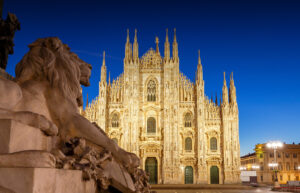The Perelman Performing Arts Center, recently unveiled, stands as one of New York’s most opulent civic structures in years. Its official inauguration is set for Wednesday, and if you’ve been near Lower Manhattan’s World Trade Center over the past year, you likely caught sight of its construction. A floating, translucent marble cube, nestled at the base of One World Trade Center, it stands at a mere eight stories tall amidst a cluster of towering commercial skyscrapers, yet commands attention. This $500 million, 129,000-square-foot endeavor arrives at a time starkly different from its conception two decades ago. Back then, New York was consumed by grief and fear, its economy plummeting, and ground zero remained a somber resting place.
Just this week, we were reminded of the toll as the names of the thousands lost were once again solemnly recited. In the wake of September 11, focus rightly centered on the families of victims, some of whom fervently advocated for the entire 16-acre site to be dedicated as a memorial. Officials grappled with reconciling these pleas with the urgent need for economic and downtown revitalization. Shiny new office towers were heralded as defiant symbols in the face of Osama bin Laden, encircled by new checkpoints and bollards, encompassing the twin memorial pools. Simultaneously, downtown residents and others argued that a response to terrorism — and what the neighborhood needed for revival — was a hub for the arts. “The community that stayed was steadfast in supporting a cultural component,” stated Catherine McVay Hughes, former chairwoman of the area’s Community Board 1, in an interview with The New York Times in 2016. “It was important that something alive gets created here, right here, at the World Trade Center site.” A generation has passed, New York has weathered other crises, and more challenges lie ahead. Perelman debuts in a post-pandemic era, with the theater industry hemorrhaging jobs, and uncertainties about the return to office work, let alone venturing to the World Trade Center for an evening of performance. Ground zero remains incomplete, with significant plots still vacant, and Perelman is just one part of the puzzle — albeit the most prominent, welcoming piece yet, distinct from a shopping mall or a Path train station. And also the most promising. Designed by architect Joshua Ramus, the building is referred to as a “mystery box,” a nod to the three ingeniously engineered, shape-shifting theaters it houses. Small, medium, and large, they’re cloaked in modular acoustic wood panels, resting on robust rubber pads that further muffle the vibrations of subways passing beneath. They can be combined and reconfigured into over 60 layouts, with raked or flat floors, collapsible or extended balconies, movable walls, and adjustable stages.
These high-tech theaters are veiled by a facade composed of thousands of half-inch-thick, intricately veined marble panels, sandwiched between delicate layers of glass. The veining forms lozenge-shaped patterns that span all four sides of the building. After nightfall, when the memorial park across the street empties, and office workers head home, Perelman illuminates like a lantern. Its white stone transforms to amber. Chandeliers in the towering corridor along the center’s curtain wall cast the silhouettes of bustling theatergoers onto the radiant marble, beckoning the neighborhood back to life. Lower Manhattan didn’t succumb, it thrived after September 11, with its residential population tripling. However, the World Trade Center has remained an unfamiliar zone. An arts institution was among the early casualties of the chaos. Frank Gehry was initially commissioned to design it, but was subsequently replaced. Tenants came and went. The Port Authority imposed the Oculus, a flamboyant, extravagant showcase building by Santiago Calatrava, to house the Path station and shopping mall. As time passed, dreams of an arts center gradually faded from memory. Yet, they never vanished.
In 2015, Ramus’s marble cube emerged victorious in an international design competition held to reinvigorate the project. The following year, cosmetics mogul Ronald O. Perelman donated $75 million to bolster funding. Ramus, now 54, had previously overseen the design of Seattle’s Central Library, one of the standout buildings of the early 21st century. At the time, he was a partner with Rem Koolhaas, co-owning their New York office. The partners eventually separated, with Ramus taking over the firm and rebranding it as Rex. Seattle’s library evidently served as a precedent for Perelman, marked by a similar obsession with rationalism and its vertiginous, adaptable interiors. It’s likely that Ramus and his team also visited the splendid Chiesa di Nostra Signora della Misericordia in Milan from the 1950s, renowned for its matte glass exterior. Another clear influence is Gordon Bunshaft’s Beinecke Rare Book & Manuscript Library at Yale, not only for its translucent marble but also for its sepulchral atmosphere. In Perelman’s case, the structural challenge was building it atop four underground stories of intricate, immovable infrastructure — a labyrinth of train tracks, ventilation ducts, and truck ramps that service the World Trade Center site. The first 21 feet above the sidewalk also fell under the jurisdiction of the Port Authority, for both practical and security reasons. Ramus collaborated with Davis Brody Bond, a seasoned New York architecture firm, and Jay Taylor, a senior principal at Magnusson Klemencic Associates, the engineering firm that worked on the original Twin Towers. Amidst the tracks and ramps, they identified distant load-bearing points in the bedrock to support a system of belt trusses, which cradle the theaters. Yielding the Port Authority its 21 feet, they elevated Perelman onto a plinth of black granite, concealing an entry stair below the south wall. The cantilevered corner of the building lifts enticingly from the sidewalk, akin to a pleated skirt. This stairway serves as the closest thing the World Trade Center has to a public stoop for gathering, which it sorely needs. Hopefully, security won’t shoo away those who choose to sit on the steps. Visitors who opt for the stairs arrive at a lobby on the building’s lower level, serving as its warm, inviting heart.
Designed by the Rockwell Group, the sculptured ceiling is adorned with lights nestled into spirals of wooden ribs. This floor of the building will be accessible to the public from morning until late at night, featuring a stage, lounge, and a restaurant by Marcus Samuelsson. Additionally, a terrace provides a vantage point akin to that of the High Line, offering a view of Lower Manhattan. Exquisitely crafted, Perelman ultimately exceeded its initial budget twofold — a sum that could have supported numerous existing community arts organizations throughout the city for countless years. The majority of the funding was privately donated, with Michael Bloomberg providing the largest contribution at $130 million. New Yorkers may recall that during his tenure as mayor, he advocated for housing and schools to be included alongside offices and a smaller memorial at the World Trade Center, though his proposal was met with resistance.
Photo via Pac NYC



